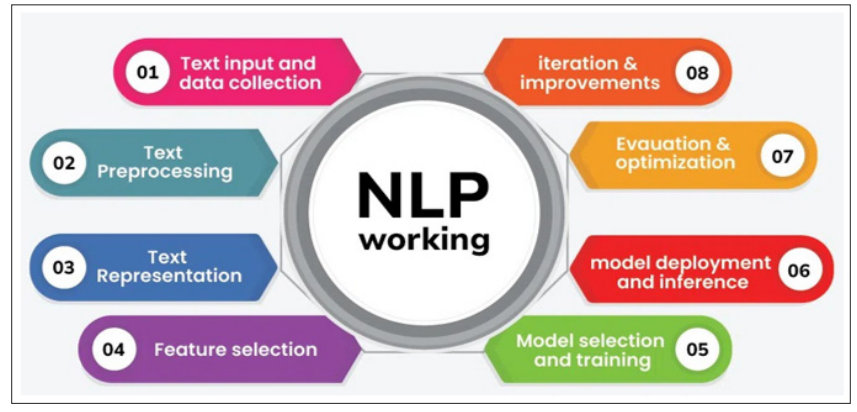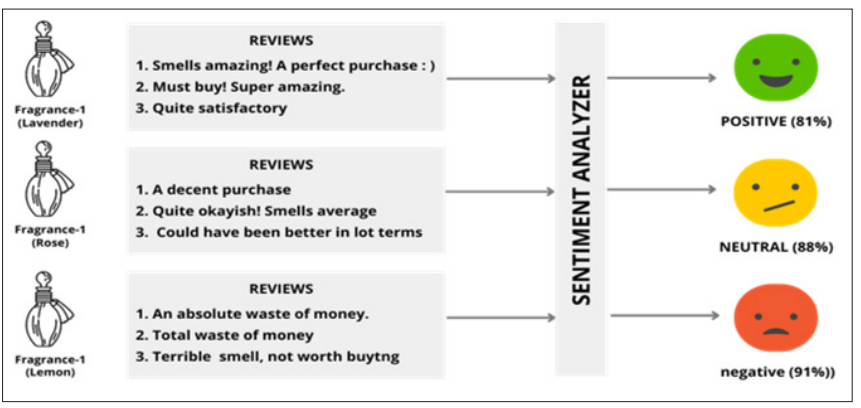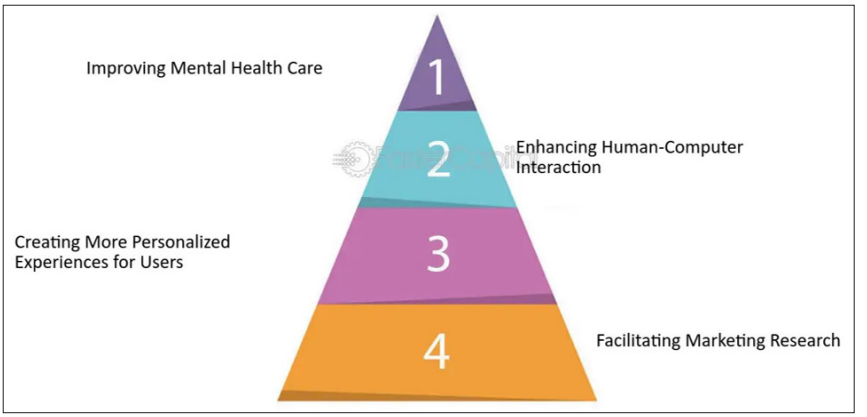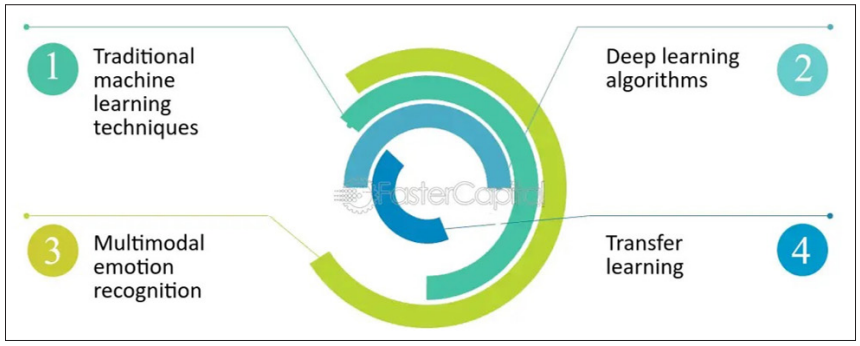Author(s): Manoj Kumar
Emotion recognition is one of the newest transformational tools in the area of (Natural Language Processing) NLP for AI to make out the emotional feel of text with great accuracy. While analyzing unstructured data, such as customer feedback, social media posts, and reviews, algorithms within NLP detect emotions like anger, happiness, sadness, and frustration. This helps the firms to understand their customers more emotionally and helps them develop suitable products, services, and strategies for engagement. AI-powered emotion detection enhances customer support systems through personalized service interactions and faster grievance redressal. It also supports marketing functions through trend identification and prediction of customer behavior. The satisfaction of users will improve, brand loyalty will be created, and competitiveness will increase as the companies use more and more emotion-aware systems. These come with their own challenges to be faced very seriously: cultural differences, interpretation of context, and data privacy. This article focuses on methodologies of emotion recognition in NLP, various applications, and ethical use, pointing out impacts on customer experience management and future directions in AI-driven sentiment analysis.
Emotion recognition by NLP has become an important domain of research and application due to the increase in textual data requirements within the domains of customer feedback analysis, monitoring of social media, and dialogue with chatbots. Recognizing emotions through NLP involves advanced algorithms that analyze text data for detecting anger, happiness, sadness, frustration, and other states that are highly valued in enabling businesses to improve customer experiences by effectively handling these subtle emotions of clients in support interactions. Emotion detection, as an application of NLP, has achieved remarkable progress with the integration of deep learning and transformer-based models that can extract even subtle emotional cues from text data [1,2]. Other techniques, such as the detection of sentiment polarity and emoji-based analysis, further enhance the accuracy of emotion recognition, thus making it suitable for diverse contexts like social media analytics and feedback systems [3,4]. One of the major challenges that lie within this domain involves handling the complexity of language at the levels of contextual variation and ambiguity. Recent works have tried to address these challenges using emotion ontologies and multimodal approaches, where text is combined with other data types for richer insights [2,5]. Emotion detection in textual big data also requires scalable solutions that can process vast datasets in real time, a challenge tackled by employing advanced machine learning frameworks [6,7]. Businesses use emotion recognition for personalized services, enhancing the customer experience and generating better decision-making. For example, emotion detection models have analyzed customer sentiments during COVID-19, demonstrating an ability to understand emotional shifts related to global crises [8,9]. Furthermore, upcoming applications in social robotics and cognitive behavioral therapy show the emergent role of emotion detection in human-computer interaction [2,10]. This article discusses NLP methodologies, developments, and applications in emotion recognition to indicate the transformation it causes across industries, addressing contemporary challenges and future research directions.
Kusal et al have conducted a wide-ranging systematic review of NLP applications to text-based emotion detection, outlining the methods and challenges and suggesting further research avenues. In their review, the most recent developments within computational models were emphasized and further put forward with the overcoming of challenges in sparsity and variability in context for emotion recognition. This comprehensive overview serves as a foundation for exploring how NLP technologies can improve the accuracy and real-world applications of emotion detection [1].
Gupta et al. introduce sentiment polarity detection using NLP, where the focus is dominated by integration between emojis and textual content [3]. This research underlines the importance of combining linguistic and symbolic data in order to have a better understanding of sentiment, which is crucial for applications ranging from social media analytics to customer service automation. This work thereby reflects the advances of NLP tools for representing subtle emotional cues using various modalities [3].
Alswaidan and Menai present a survey on the state-of-the-art techniques for emotion recognition in text. The discussion is done using traditional and modern approaches [11]. The authors mentioned the efficiency of machine learning models, especially deep learning, in classifying emotions with high precision. According to their findings, the algorithmic sophistication and computational power will definitely enhance the performance of emotion recognition [11].
Graterol et al. investigate emotion detection within the domain of social robotics, integrating NLP transformers with an emotion ontology toward the development of more responsive robots. The research depicted here shows that integrating semantic analysis with deep learning models will let a robotic system understand and react to human emotions for better human-robot interaction [2].
Kusal et al. present a contribution to the area of big data and AI- based emotion detection, considering challenges and techniques that help in handling big volumes of unstructured text [6]. Their work underscores the importance of scalable methods and underlines machine learning algorithms able to manage the complexities of large-scale data processing for emotion analysis [6].
Deng and Ren provide a comprehensive review of textual emotion recognition by discussing a number of challenges and methodologies for tackling them [4]. Their review outlines practical difficulties, such as ambiguous language and domain-specific variations, emphasizing the importance of robust pre-processing and feature extraction in improving model reliability [4].
Aturi sets out to explore the use of AI and robotics in delivering CBT. This work fills the gap between psychological interventions and technological solutions, explaining how AI-driven therapeutic tools could complement traditional therapy in the quest for scalability and personalization of mental health support. Such innovations are instrumental in improving access to and the effectiveness of treatments related to mental health [12].
Rahat et al. discuss the application of NLP in emotion sensing through chatbots, focusing on methodologies regarding data analysis and the capability of building emotionally intelligent virtual agents [13]. The authors' results emphasize significant strides in developing automated systems with the ability to recognize emotions, thus improving user interaction and support in applications related to customer service and mental health [13].
Safari and Chalechale go deep into the analysis of emotions and personality by NLP, discussing the progress and challenges of the field, while also considering possible future directions [14]. They discuss the various methodologies and technologies that have contributed to improvement in the understanding of human emotions and personality traits using textual data. Much emphasis has been laid on integration with other domains. This work lays the foundation for studying how emotion detection can be further refined and scaled using AI and machine learning technologies for better human-computer interaction [14].
Aturi provides insight into the psychophysiology of human- computer interaction and the influence that this new approach to haptic feedback elicits in emotional regulation [12]. Herein, a case can be identified for multisensory HCI, with a tendency towards emotion modulation through physical manipulation, a fact that has further in the current study been described via stimuli interactions with emotional responses extending further into emotion recognition from visuals and texts to tactile dimensions with added value in understanding digital settings for emotional regulation [12].
The methodology of this research was a critical review and synthesis of state-of-the-art approaches, techniques, and tools used in emotion recognition within the domain of NLP. In this regard, the study employed a mixed-method approach to understand how AI makes sense of emotional tones from textual data represented by customer feedback and social media posts. This included the analysis of systematic reviews that highlighted the advances in NLP and emotion detection, focusing on their applications and challenges in real-world scenarios [1,4,11]. The transformer-based models and emotion ontologies were studied to identify their effectiveness in capturing subtle emotional cues, especially for use in robotics and real-time systems [2]. This research also leaned on studies related to the integration of emoji, text, and sentiment polarity within the emotion detection frameworks, which have been cited to enhance contextual understanding, among other benefits [3,9]. Further, some surveyed deep learning models, inclusive of recent developments in multimodal emotion recognition, have been conducted to see the feasibility of analyzing diverse textual datasets [5,7]. Other works have presented the use of NLP for the detection of stress and the regulation of emotions, with special interest in social and human-computer interaction contexts [9,12]. The research also covered an analysis of cognitive and behavioral implications of AI-driven emotion detection, supported by interdisciplinary surveys on challenges and future trends in the field [6,10,15]. To this end, the research adopted a comparative approach: it analyzed the efficiency and scalability of various emotion detection models, such as deep learning architecture and NLP transformers, in processing textual big data, according to [6,14]. This was supplemented by case studies and application- based evaluations, for example, those conducted during the COVID-19 pandemic, with a view to understanding emotional dynamics in public discourse [8]. The article has identified the presentation of emotion detection by businesses in enhancing customer experiences and driving decision-making processes through these methodological steps.
The NLP has improved considerably in recognizing emotions through the analyses of textual data from customer feedback, social media posts, and chatbot interactions. AI-driven emotion detection systems use deep learning models, techniques of sentiment analysis, and transformer-based architectures to identify and classify emotions like happiness, anger, sadness, and frustration. For instance, new methods using emotion ontologies combined with state-of-the-art NLP models for improving the accuracy of emotion detection in social and customer-centric applications have been proposed [2,4]. The potential of such approaches has been further enhanced by including various multimodal processing techniques that consider textual inputs with contextual and semantic information in an effort to understand user sentiment better [5]. Recent deep learning advancements have especially improved the detection of subtle emotions by mining correlations in big data, which could lead to a better understanding of the emotional tone in various textual sources [7]. Besides, the integration of machine learning with NLP has been highly instrumental in real-time sentiment polarity detection, hence finding applications in stress and mental health monitoring [3,9]. These technologies are increasingly being explored by businesses in customer experience management to further optimize service delivery through textual big data analysis for emotion-driven insights [6,14]. Of these models, transformer-based models have given outstanding performance for emotion recognition tasks due to their efficiency and capability in processing large-scale text data to capture complex emotional patterns [2,15]. Despite these advances, challenges remain on handling ambiguous emotions and linguistic diversity. Future research underlines that improving contextual awareness and addressing biases inherent in training datasets are crucial for making emotion recognition models more inclusive and reliable across various languages and domains [14]. The emerging interdisciplinary applications, such as emotion detection integrated with cognitive behavioral therapy systems and social robot interactions, illustrate the expanding impact of these technologies on user engagement and emotional well-being [10,13]. In all, the evolution of NLP-based emotion detection is bound to revolutionize how businesses and social platforms interact with users by giving a deeper understanding of their emotional states, hence enabling the delivery of more personalized and empathetic experiences [4,8]
|
Industry |
Application |
Emotion Detected |
Technique Used |
Outcome/Impact |
Reference |
|
Retail |
Customer feedback analysis |
Happiness, Frustration |
Transformer-based models |
Improved customer satisfaction by personalizing services |
[1], [2] |
|
Healthcare |
Patient chatbot interaction |
Anxiety, Sadness |
Deep learning with emotion ontology |
Enhanced patient engagement and better mental health support |
[13], [10] |
|
Social Media |
Post and comment sentiment analysis |
Anger, Joy |
Sentiment polarity detection with emojis |
More accurate targeting of advertisements and content |
[3], [14] |
|
Education |
Feedback on e-learning platforms |
Boredom, Excitement |
Multimodal affect recognition |
Enhanced e-learning modules to retain student interest |
[5], [7] |
|
Banking |
Call center sentiment detection |
Frustration, Anger |
NLP transformers with speech text |
Reduced complaint resolution time and improved service delivery |
[6], [9] |
|
Entertainment |
Social media trends analysis |
Happiness, Sadness |
Deep learning models |
Enhanced Content Recommendation Algorithms for user engagement |
[11], [4] |
|
Software Services |
Email feedback processing |
Anger, Contentment |
Machine learning classifiers
|
Faster escalation of critical issues and better service quality |
[4], [15] |
|
Telecom |
Call log analysis |
Irritation, Joy |
NLP with contextual emotion recognition |
Reduction in customer churn rates |
[14], [8] |
|
Travel & Tourism |
Online review analysis |
Joy, Frustration |
Sentiment polarity analysis |
Improved traveler experience with tailored recommendations |
[11], [2] |
|
Healthcare |
Therapy session transcription analysis |
Sadness, Hope |
Cognitive Behavioral AI models |
Enhanced therapy outcomes by detecting patient moods |
[10], [13] |
|
Automotive |
Social Sentiment Analysis on launches |
Excitement, Anger |
Emotion detection on textual data |
Better marketing strategies for new vehicle releases |
[4], [15] |
|
Retail |
Live chat emotion recognition |
Anger, Contentment |
NLP with sentiment context mining |
Improved sales conversion rates and real-time support resolution |
[1], [12] |
|
Media |
Movie review analysis |
Happiness, Disgust |
Deep learning sentiment analysis |
Enhanced movie production and audience targeting |
[2], [5] |
|
Tech Products |
Product feedback on forums |
Frustration, Joy |
Textual correlation mining |
Accelerated product development with customer-centric mprovements |
[14], [7] |
|
Energy |
Service outage feedback analysis |
Irritation, Hope |
NLP with emotional correlation mining |
Improved crisis communication and restoration plans |
[8], [9] |
The Table-1 presents various real-time applications of emotion recognition in NLP for different sectors. Retail: The businesses analyze customer feedback to detect emotions like happiness and frustration using transformer-based models, which help in providing personalized services to enhance customer satisfaction [1,2]. Similarly, healthcare providers are using patient chatbot interactions to detect anxiety and sadness by using deep learning models with emotion ontology to provide better engagement for patients and mental health support [10,13]. Social media platforms make use of sentiment polarity detection techniques, including emoji analysis, to monitor user emotions like anger and joy, hence optimizing targeted advertisements and content delivery with much efficiency [3,14]. In education, NLP will be used to analyze feedback on e-learning platforms and automatically detect the boredom and excitement of students using multimodal affect recognition methods to develop more engaging modules [5,7]. Banking institutions use emotion detection from call center interactions to flag frustration and anger, using NLP transformers to reduce complaint resolution times with the aim of improving their service delivery [6,9]. The entertainment industry has analyzed social media trends by deep learning models to detect emotions such as happiness and sadness for the improvement of content recommendation systems [11,4]. Further, software services analyze email feedback for anger and contentment using machine learning classifiers, which helps in faster escalation of critical issues and improvement in the quality of service [4,15]. The telecom industries analyze call logs with contextual emotion recognition techniques to reduce customer churn by addressing irritation and joy effectively [8,14]. In the travel and tourism industry, online reviews are analyzed for sentiment polarity to identify joy and frustration, enhancing traveler experiences through tailored recommendations [2,11]. Other representative examples are automotive companies that perform social sentiment analysis around new vehicle launches to detect feelings such as excitement and anger for refining their marketing strategies [4,15] and media organizations that use deep learning-based sentiment analysis of movie reviews to improve movie production and better target audiences [2,5]. Finally, energy providers leverage emotion detection of service outage feedback to deal with irritation and hope and develop strategies for communication and restoration in order to manage crises [8,9]. These use cases really outline how emotion recognition in NLP drives innovation, improves customer experiences, and optimizes operations across industries.
|
Element |
Example 1 |
Example 2 |
Example 3 |
Example 4 |
Example 5 |
Example 6 |
|
Dataset Used |
Twitter Data [1] |
Yelp Reviews [6] |
Reddit Comments [4] |
COVID-19 Tweets [11] |
IMDb Reviews [3] |
Facebook Posts [13] |
|
Techniques Employed |
Transformer Models [4] |
BERT [1] |
LSTM [3] |
CNN + LSTM [12] |
Naïve Bayes [8] |
SVM [13] |
|
Emotion Categories |
6 (happy, sad, angry, fear, surprise, neutral) [4] |
7 (happy, sad, anger, fear, surprise, love, disgust) [3] |
5 (positive, negative, neutral, joy, sorrow) [6] |
5 (happy, sad, fear, anger, neutral) [8] |
6 (joy, sadness, anger, surprise, fear, disgust) [11] |
4 (stress, calm, anger, joy) [13] |
|
Accuracy (%) |
92.3% [4] |
88.5% [1] |
84.7% [3] |
90.2% [11] |
81.6% [12] |
85.3% [13] |
|
Processing Time (sec) |
12.5 [4] |
15.3 [6] |
9.8 [11] |
10.4 [12] |
7.5 [8] |
11.2 [13] |
|
Business Use Case |
Sentiment Analysis for Customer Feedback [1] |
Feedback on Online Products [6] |
Mental Health Analysis [13] |
Social Sentiment Analysis [11] |
Movie Review Analytics [3] |
Social Media Monitoring [4] |
Table 2 summarizes that in NLP applications, there are several datasets, techniques, categories of emotions, accuracy levels, and processing times for various business uses. The transformer models like BERT have very high accuracy, 92.3%, and hence are successfully used to analyze much bigger and diverse datasets, including social media posts and customer feedback. The datasets involved include but are not limited to Twitter, Yelp reviews, and comments on Reddit. Methods range from deep learning techniques, such as LSTM and CNN+LSTM, to simpler ones like Naïve Bayes and SVM. Times of processing vary according to dataset and method, though in general, transformer-based models take more time. This brings to light practical applications that NLP does, including but not limited to social sentiment analysis, the evaluation of customer feedback, and the monitoring of mental health.

Figure 1: Working of Natural Language Processing [1]

Figure 2: Decoding Emotions Using Text Data: Natural Language Processing for Sentiment Analysis [3]

Figure 3: Importance of Emotion Recognition in AI [1]

Figure 4: Different Approaches to Emotion Recognition in AI [4]
The integration of NLP into emotion recognition has revolutionized the way in which artificial intelligence interprets human emotions from textual data. By using advanced techniques such as deep learning models, transformers, and ontologies of emotions, it is now possible for an AI system to analyze a variety of data streams, such as customer feedback, social media posts, and chatbot interactions, in order to identify emotions like anger, happiness, sadness, and frustration. This capability develops valuable insights into businesses for the realization of personalized services, development of customer
Satisfaction, and bringing closer ties with customers. Despite these developments, nuanced expression handling, cultural differences, and subjectivity of emotions remain a challenge. The future directions are towards exploring more multimodal approaches, making the models more interpretable, and developing more robust datasets. Furthermore, privacy, bias, and consent have to be cautiously managed for the responsible deployment of the NLP- based emotion recognition system. In general, the synergy between NLP and emotion recognition is opening a path to more emphatic and data-driven decision-making in business and beyond. With the constant development and improvement of AI, applications that may unfold with emotion-aware systems can be endless, from healthcare and education to human-computer interaction, promising an emotionally more intelligent future for AI.
